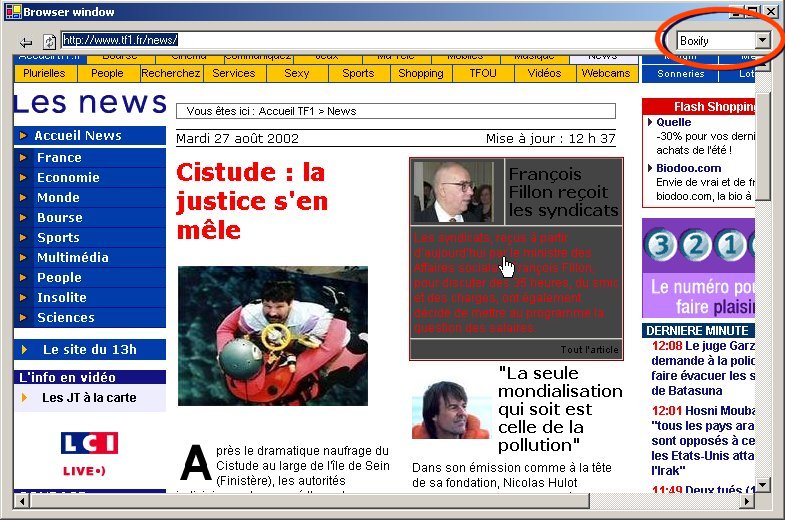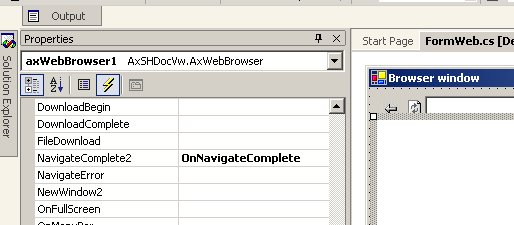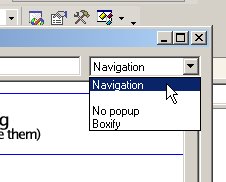Html Gets Hooked

Interactively highlight blocks in any arbitrary web page
This article shows how to take control of the content browsed in web pages while surfing. A few applications are described and provided in the demo app. Though the demo app is written using C#, the audience is much larger as the code involved can be directly translated to C++, VB or other languages. Besides that, Html hooking is mostly done by Javascript.
Html hooking ?
After 6 major releases of Internet Explorer, users are still stuck with a rather basic browser. As long as your only need is browse, everything is ok. Internet Explorer allows one to surf easily but what if you want to reuse an interesting part of a web page, subscribe to content updates, automate processing and so on ? In fact none of this is addressed in Internet Explorer 6.0 and those who try to take control of Html face a giant gap :- Html is a language with display semantics. Html can not describe components, table of contents, and so on. That's why the industry is hard trying to introduce new languages. However significant years will be required to eradicate Html, let aside high-tech investment downturn.
- Html is provided by stateful web servers that take advantage of cookies and session ids to serve content, making web pages in turn hard to work with.
- Html is the processing result of higher level server-side languages used by web developers. Html is thus a flatten form with no other aim or ability than be displayed as is.
- There is no simple Html used in web sites these days, as every web developer uses a sausage of javascript, dynamic html, multi-layered event-driven flavor of Html. To reuse Html in your application, you need both of these run-times.
Html hooking technically speaking is a way for developers to subscribe for specific browser events in the goal of providing end-users with browser++ software, applications whose aim is to browse as smartly as possible and make the web a better, more reliable, place to work with.
Html is in some way already fully hookable, as almost every Html tag can be attached behaviours associated with clic events. But this doesn't really result in applications because the events work with Html in the same highly protected web page space, giving very few if any hooking capabilities to the developer, and in turn very few additional features to the end-user.
The Internet Explorer API allows us to host a web browser instance and subscribe for specific events such like being signaled a page has been loaded and is in interactive mode. By taking advantage of this event, a few other tweakings and the fact that the Internet Explorer API provides the Document Object Model (as well), we are going to apply changes to Html code between the moment a web page is just loaded and the moment the web page is ready and displayed, giving us the ability to control what is actually seen and how it behaves. Let us begin with a first example.
Highlighting blocks in an arbitrary web page
Starting from a standard Form-based C# application, we drop the web browser control onto it, and subscribe for the event fired when the web page is ready, namely OnNavigateComplete :
Subscribing for the page-ready event
When the page is ready, if we want to change the Html code or apply events, we can take advantage of a method called
execScript available at the IHTMLWindow level and provide it with javascript code :
// event called when the web browser updates its view and finishes parsing a new web page
private void OnNavigateComplete(object sender,
AxSHDocVw.DWebBrowserEvents2_NavigateComplete2Event e)
{
String code = <...some javascript code...>
// exec Javascript
//
IHTMLDocument2 doc = (IHTMLDocument2) this.axWebBrowser1.Document;
if (doc != null)
{
IHTMLWindow2 parentWindow = doc.parentWindow;
if (parentWindow != null)
parentWindow.execScript(code, "javascript");
}
}
That's now we need the javascript magics. How can we highlight blocks ? This raises two questions : what is a block when all we have is a hierarchical tree of Html tags (the infamous DOM) ? how to do highlighting ?The first question answer is obvious from the experienced web designer point of view. Needless to say that 90% of web pages use <table> tags to position the content in the web page. Lucky we are, we are able to assume that table blocks are in fact web components, for instance navigation bars, main content, credit bar, and so on. Of course, this is not always true, but this is way true. Just try it, that's demonstration by the example !
Html reverse engineering will be discussed in another article.
The second answer follows the first. We are going to check Html elements under the mouse cursor. The processing needs to be fast enough to avoid to uselessly slow down the surfing experience. We simply use the DOM capabilities to traverse element parents from the current element and we seek for a <table> tag. Once we have got it, we just change on-the-fly its border and background color so it highlights. We are of course lucky guys because each change we do is automatically reflected in the web page without full refresh, that's one of the benefits of dynamic Html. Here we go with the javascript code (boxify.js) :
document.onmouseover = dohighlight;
document.onmouseout = dohighlightoff;
var BGCOLOR = "#444444";
var BORDERCOLOR = "#FF0000";
function dohighlight()
{
var elem = window.event.srcElement;
while (elem!=null && elem.tagName!="TABLE")
elem = elem.parentElement;
if (elem==null) return;
if (elem.border==0)
{
elem.border = 1;
// store current values in custom tag attributes
//
elem.oldcolor = elem.style.backgroundColor; // store backgroundcolor
elem.style.backgroundColor = BGCOLOR; // new background color
elem.oldbordercolor = elem.style.borderColor; // same with bordercolor
elem.style.borderColor = BORDERCOLOR;
var rng = document.body.createTextRange();
rng.moveToElementText(elem);
// following code is in comment but ready to use if required
// -> it can select the highlighted box content
// -> or put automatically the content in the clipboard to ease copy/paste
/* var bCopyToClipboardMode = 1;
if (!bCopyToClipboardMode)
rng.select();
else
rng.execCommand("Copy"); */
}
}
function dohighlightoff()
{
var elem = window.event.srcElement;
while (elem!=null && elem.tagName!="TABLE")
elem = elem.parentElement;
if (elem==null) return;
if (elem.border==1)
{
elem.border = 0;
// recover values from custom tag attribute values
elem.style.backgroundColor = elem.oldcolor;
elem.style.borderColor = elem.oldbordercolor;
}
}
To play with interactive highlighting, we have a combobox in the right hand-corner on the application. Here is how the combobox has been developed : we have dropped this component from the Toolbox Window onto the Form, then inserted the selectable options in the Items Collection from the Properties Window, and chose "DropDownList" as combo-box style to disable edition. One thing we could'nt do from the Properties Window was to select the initial index, and had to manually add code for it : this.comboBox1.SelectedIndex = 0;. Resulting in that combo-box of me :
Adding an unusual combo-box to a web browser app
As the combo-box inherently means, in this article we are here with a few other hookings to play with. Let me first introduce how state switching is managed :
protected enum NavState
{
None,
NoPopup,
Boxify
};
// event called when selection changes in the combobox
private void OnNavigationModeChanged(object sender, System.EventArgs e)
{
if ( comboBox1.Text=="NoPopup" )
{
NavigationState = NavState.NoPopup;
}
else if ( comboBox1.Text=="Boxify" )
{
NavigationState = NavState.Boxify;
}
else
{
NavigationState = NavState.None;
}
// synchronize UI
SyncUI("");
}
// event called when the web browser updates its view and finishes parsing a new web page
private void OnNavigateComplete(object sender,
AxSHDocVw.DWebBrowserEvents2_NavigateComplete2Event e)
{
String sURL = (string) e.uRL;
if (sURL=="about:blank")
return;
SyncUI( sURL );
}
// applogic
//
protected void SyncUI(String sURL)
{
if (sURL.Length>0)
textBox1.Text = sURL; // update UI
String code;
if ( NavigationState == NavState.NoPopup )
{
// squeeze down onload events (when web page loads)
String code1 = "document.onload=null;" +
"window.onload=null;" +
"for (i=0; i<window.frames.length; i++) { " +
" window.frames[i].document.onload=null;window.frames[i].onload=null; };";
// squeeze down onunload events (when web page is closed)
String code2 = "document.onunload=null;" +
"window.onunload=null;" +
"for (i=0; i<window.frames.length; i++) { " +
" window.frames[i].document.onunload=null;window.frames[i].onunload=null; };";
code = code1 + code2;
}
else if ( NavigationState == NavState.Boxify )
{
// read boxify.js
FileStream fin = new FileStream("boxify.js", FileMode.Open, FileAccess.Read, FileShare.ReadWrite) ;
StreamReader tr = new StreamReader(fin) ;
code = tr.ReadToEnd();
tr.Close();
fin.Close();
if (code.Length==0) Console.WriteLine("Cannot find boxify.js file");
}
else
{
// stop boxify.js
//
code = "document.onmouseover = null; document.onmouseout = null;" ;
}
// exec Javascript
//
IHTMLDocument2 doc = (IHTMLDocument2) this.axWebBrowser1.Document;
if (doc != null)
{
IHTMLWindow2 parentWindow = doc.parentWindow;
if (parentWindow != null)
parentWindow.execScript(code, "javascript");
}
}
Banning popups
Another nice Html hooking is the one for preventing popups from opening. Web designers are used to the technique of executing javascript when quitting the current web page, and a lot of them use it on the purpose of opening popup pages (especially p0rn). What we do is, once the page is ready, overwrite these "callbacks" and force them tonull.Because the DOM is a rather richer object model, it is not enough to force
null at the document level (the object representing the web page), we need to do this at the window level, and at any subwindow levels, known as frames.See code above.
Saving Html for reuse
Even if saving Html for reuse deserves an article for itself, let me just initiate the few lines of code needed to do just that. In fact if we used C++ we would have casted theIHTMLDocument interface to IPersistFile and applied the Save() method on it, but in C# the replacement for IPersistFile is known as UCOMIPersistFile, in the System.Runtime.InteropServices namespace. What follows is what is needed to store the Html code on your hard drive using C# :IHTMLDocument2 doc = (IHTMLDocument2) this.axWebBrowser1.Document; UCOMIPersistFile pf = (UCOMIPersistFile) doc; pf.Save(@"c:\myhtmlpage.html",true);That's easy.
Stephane Rodriguez-
August 27, 2002.
Home
Blog